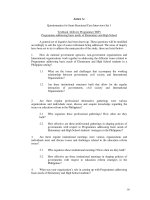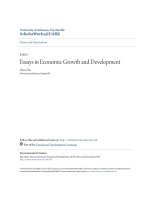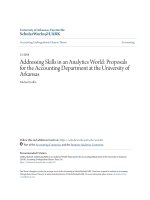Accounting undergraduate Honors theses: It''s a business: A financial analysis of the BCS system and its alternatives
Bạn đang xem bản rút gọn của tài liệu. Xem và tải ngay bản đầy đủ của tài liệu tại đây (229.9 KB, 13 trang )
University of Arkansas, Fayetteville
ScholarWorks@UARK
Accounting Undergraduate Honors Theses
Accounting
5-2013
It's a Business: A Financial Analysis of the BCS
System and Its Alternatives
Wilson Neely
University of Arkansas, Fayetteville
Follow this and additional works at: />Part of the Accounting Commons, and the Sports Management Commons
Recommended Citation
Neely, Wilson, "It's a Business: A Financial Analysis of the BCS System and Its Alternatives" (2013). Accounting Undergraduate Honors
Theses. 4.
/>
This Thesis is brought to you for free and open access by the Accounting at ScholarWorks@UARK. It has been accepted for inclusion in Accounting
Undergraduate Honors Theses by an authorized administrator of ScholarWorks@UARK. For more information, please contact ,
It’s a Business: A Financial Analysis of the BCS System and Its Alternatives
by
Wilson Pace Neely
Advisor: Dixon Cooper
An Honors Thesis in partial fulfillment of the requirements for the degree Bachelor of
Science in Business Administration in Accounting
Sam M. Walton College of Business
University of Arkansas
Fayetteville, Arkansas
May 11, 2012
1
INTRODUCTION
We all love college football for a reason. The players on the field know that they have no
more than four years to leave their mark at their respective school. The emotion that results from
an 18-22 year old playing for the name on the front of his jersey is something that has captivated
our country. College football has produced long-standing traditions, rivalries, and even territorial
identities. The fans in SEC country tailgate the longest, drink the most, and claim to be
associated with the best conference that college football has to offer. In the North, or Big Ten
land, they like to think of themselves as classic, holding some of the oldest rivalries, richest
traditions, and large alumni endowments. There’s the West Coast, where Pac-12 fans are hip,
flashy, and love to watch high-powered offenses collide. Just to the left of SEC country, there’s
Big 12 territory. Just ask a University of Texas alumnus and they will tell you that they went to
school in the best conference the country has to offer, mainly because it features four schools
from Texas. These identities, and the pride that comes with them, are direct products of what
happens on the field where young men give blood, sweat, and tears to play for the love of the
game. That’s what makes college football different than the NFL; it’s not all about the money.
It’s not a business. Or is it?
The Bowl Championship Series, commonly known as the BCS, was established in 1998
to provide structure for the postseason of college football. The BCS created a system that would
ultimately allow the top eight teams in the country to play in four marquee bowl games-Sugar,
Fiesta, Rose, Orange-creating a designation for the “best” bowls (Note: Beginning with the 2006
season, the addition of the BCS Nat. Champ. as a separate event brought the total number of
BCS bowl teams to ten). College football was, and still is, the only college sport to not have its
postseason champion crowned through a tournament format. The BCS gave the sport somewhat
of a vertical postseason structure, as opposed to the previous format that pinned teams in various,
yet equal bowl games. The BCS continues to provide increased revenues every year for both
Automatic Qualifier (AQ) conferences, as well as non-AQ conferences, but every year a debate
is raised about the legitimacy of the BCS. Through the years, two main alternatives have
emerged: the Plus One format, and the Playoff format.
Under the current BCS format, 10 teams are selected to play in the five different bowls, at
four locations (the BCS National Championship is played at the same site as one of the other
four bowls, rotating locations each year). For the sake of this thesis, everything within the current
BCS format will remain the same.
Under the Plus One scenario, the BCS poll would be used to determine the top four teams,
and those teams would compete, bracket style, for the championship title. There would be two
semi-final games, and the winners of those games would compete in a championship game. The
difference in the Plus One and the Playoff, aside from less teams, is that the current BCS bowls
would still exist. The BCS National Championship would be played every year, but the two first
round games would rotate between the Sugar, Fiesta, Rose, and Orange bowls.
Under the Playoff scenario, the BCS poll would be used to select the top eight teams in the
country, who would then play a bracket style tournament. The first round of games (4 games)
would be held at the home fields of the higher ranked teams, and the semi-finals (2 games) and
championship (one game) would be help at a neutral location, similar to the NCAA Final Four.
Also, there would be one BCS committee, with no individual committees for each bowl.
The main purpose of this thesis is to determine which of the three postseason scenarios
offers the greatest profitability. Secondary to that, I will evaluate the current stances on each
format.
2
Scenario One: The Current BCS Format
First, let’s explain how the whole cash flow process works for the current postseason
format of college football. Each bowl game receives its individual revenue from a number of
different sources including ticket sales, appropriation from the host state, sponsorships, interest
and dividends, licensing royalties, game programs, hotel accommodations, etc. That revenue is
then allocated amongst several expense categories including the BCS organization, an operating
budget, marketing, improvements, etc. The BCS organization aggregates its distributions from
each of the five bowls, combines that money with TV and Title Sponsorships, then redistributes
that money to the FBS (Football Bowl Series) conferences.
Upon a quick glance, the current BCS format looks like a great model. According to
NCAA.org, the current system boasts annual revenue growth dating back to the 2004 season. As
you can see in Figure One, the percentage increases are relatively constant excluding the 20062007 season and the 2010-2011 season. The 2006-2007 season features a large spike in revenue
due to the addition of the BCS National Championship as a fifth bowl, and the 2010-2011 season
revenue spike can be credited to the commencement of a new media deal between University
presidents and ESPN (Tillman 2008).
Figure One- BCS Revenue (NCAA.org 2011)
Year
2004-2005
2005-2006
2006-2007
2007-2008
2008-2009
2009-2010
2010-2011
Total
Total BCS Revenue
$122,121,892.00
$125,893,334.00
$142,564,052.00
$145,826,923.00
$148,164,228.00
$155,170,610.00
$181,912,310.00
$1,021,653,349.00
Change ($)
$3,771,442.00
$16,670,718.00
$3,262,871.00
$2,337,305.00
$7,006,382.00
$26,741,700.00
Change (%)
3.09%
13.24%
2.29%
1.60%
4.73%
17.23%
The Total BCS Revenue in Figure One is the sum of the fixed revenue distribution from
each bowl to the BCS, plus the Television and Title Sponsorships. Looking at these numbers
would lead you to believe that the current format is an extremely profitable one. However, it’s
necessary to keep in mind that the revenue distributions from each bowl are not the same as the
total revenue earned by each bowl. Yes, the distributions are a byproduct of the total bowl
revenue, but profitability of each format will be determined by the sum of the TOTAL profits of
each bowl, not just the distribution. To really figure out the profitability of the current BCS
format, you have to look past the slanted BCS distribution numbers and figure out how much
each game makes individually. Figure One is provided to give you an idea of the kind of money
that the BCS entity accumulates before it redistributes funds back to the schools. Although these
numbers look good, they do not represent the profitability that we are searching for in this thesis.
To measure the true profitability of the current BCS format, I first needed to find how
profitable each bowl was. To calculate the profit of each bowl, I looked up its Form 990 (return
for organizations exempt of income tax) for each year from 2007-2010, found the profit by
subtracting total expenses from total revenues, and then took the average of that figure for all
four years. I only used data starting in 2007 because that was the first year to feature all five
games. Conversely, I couldn’t use 2011 figures because tax returns have not yet been released
for tax year 2011. Once I calculated average profits for all five games, I added back their average
payouts to the BCS organization (NCAA.org 2011), so as to represent the total profit from the
bowl. Finally, I added all five average profits together to give me the true average profit of the
current BCS format. The results of my statistical analysis can be seen in Figure Two.
3
Figure Two- Average Profits from 2007-2010
Bowl Game
Revenues
Expenses
Profit (Loss)
Fiesta
$15,197,067.50
$14,133,324.25
$1,063,743.25
Sugar
$13,830,941.00
$11,982,446.25
$1,848,494.75
Orange
$18,371,065.75
$17,022,740.75
$1,348,325.00
Rose
$31,713,814.75
$30,726,768.25
$987,046.50
Nat. Cham.
$25,303,334.25
$22,294,420.25
$3,008,914.00
BCS Payout
$6,000,000.00
$6,000,000.00
$6,000,000.00
$33,758,528.75
$6,177,924.50
Pre-payout
Profit
$7,063,743.25
$7,848,494.75
$7,348,325.00
$34,745,575.25
$9,186,838.50
Total Profit
$66,192,976.75
*all tax returns found on PlayoffPAC.com
As you can see, there’s a reason why they call the Rose Bowl “The Granddaddy of Them
All”. In this scenario, it composes almost half of the total profit from the postseason games.
Ironically, the Rose Bowl also holds the lowest profit after BCS payouts. Nevertheless, the
existence of the Rose Bowl every year is a main reason why the powers that be would prefer to
keep the current BCS format in tact. Under the Playoff scenario, the Rose Bowl wouldn’t even
exist, and under the Plus One scenario, it would only be played once every two years. Seeing as
the BCS National Championship game’s location rotates from bowl to bowl, financials from both
games at the specified location are reported on the same tax return. For example, last season’s
National Championship was played at the Superdome -the site of the Sugar Bowl- in New
Orleans. Therefore, the number next to “Total Revenue” on the Sugar Bowl’s tax return
represents revenue from both the Sugar Bowl as well as the National Championship game. With
that being said, Figure Three shows what the combined revenues/expenses/profits look like from
the National Title/Bowl X from 2007-2010.
Figure Three- Combined Financials from Nat. Cham. Plus (Host Bowl)
Year
Revenues
Expenses
Income (Loss)
2007 (Fiesta)
$19,776,042.00
$20,878,218.00
($1,102,176.00)
2008 (Sugar)
$34,091,850.00
$22,481,486.00
$11,610,364.00
2009 (Orange)
$40,799,568.00
$34,380,676.00
$6,418,892.00
2010 (Rose)
$107,759,214.00
$100,614,982.00
$7,144,232.00
BCS Payout
$12,000,000.00
$12,000,000.00
$12,000,000.00
$40,770,610.00
Pre-payout Profit
$10,897,824.00
$23,610,364.00
$18,418,892.00
$47,914,842.00
Although all of the pre-payout profits are inflated above their normal average, the Rose
Bowl’s remains head and shoulders above the rest. The statistics displayed in Figure Three
further validate the notion that the Rose Bowl is the key component to the current BCS format.
The fact that the National Championship is played at a host bowl instead of its own site is
something else that current format supporters like to point to as an advantage. Those supporters
believe that two games in a recognized location allows for the bowl entities, as well as their
surrounding communities, to capitalize on the influx of out of town visitors. Since all of the BCS
bowls are within a week of each other, the bowl committees and communities hope that their out
of town visitors can be persuaded to purchase tickets (not to mention lodging, meals, etc.), to
both games. If not, hopefully they will want to stay in the host city just to enjoy the atmosphere
of both games. Supporters of the current BCS format see the “two games, one location” plan as a
way to maximize income from visitors who may not have a reason to otherwise travel to the
specified bowl locations. Total profit from current BCS format: $66,192,976.75.
4
Scenario Two: The Plus One Format
The Plus One format is the alternative most frequently considered as of late, and is the one
that most closely resembles the current format. This format has a large support group because it
combines the tournament style format of the playoff scenario, but preserves the current BCS
format to some extent by having two BCS bowls serve as the semi-final games. To determine the
value of the Plus One format, I first needed to find the value of the semi-final round. To do that, I
used the bowl values determined in Scenario One (highlighted in Fig. Two) to create a four-year
average assuming that the four bowls rotate every year. As you can see in Figure Four, the years
featuring the Rose Bowl produce much greater profits. Nevertheless, an average of all four
combinations provides us with the most accurate representation of the semi-finals’ value.
Figure Four- Plus One Semi-Final Profits
Profit
Avg. Profit
Year 1 (F,O)
$14,412,068.00
Year 2 (O,R)
$42,093,900.00
Year 3 (R,S)
$42,594,070.00
Year 4 (S,F)
$14,912,238.00
$28,503,069.00
In order to find the total value of the Plus One format, the value of the two semi-final
games must be combined with that of the National Championship. Different from Scenario One,
the National Championship would be played at a pre-determined, “neutral” site. Using data from
2007-2010, I was able to find the average value of the National Championship, as shown in
Figure Five.
Figure Five- Plus One National Championship Profit
Year
Revenues
Expenses
Income (Loss)
2007
$9,888,021.00
$10,439,109.00
($551,088.00)
2008
$17,045,925.00
$11,240,743.00
$5,805,182.00
2009
$20,399,784.00
$17,190,338.00
$3,209,446.00
2010
$53,879,607.00
$50,307,491.00
$3,572,116.00
Average
$25,303,334.25
$22,294,420.25
$3,008,914.00
BCS Payout
$6,000,000.00
$6,000,000.00
$6,000,000.00
$6,711,698.00
$6,177,924.50
Income before
payout
$5,448,912.00
$11,805,182.00
$9,209,446.00
$10,283,814.00
$9,186,838.50
Based on the model, the average profit of a National Championship is just over $9M.
However, this average is based on games that were played at a shared site with a separate bowl
game. Given that this game is a true championship as a result of tournament play, and the only
game at its site, it’s safe to assume that ticket prices and other product prices would be inflated.
Furthermore, as the relationship between previous National Championships and various bowls
games go, the National Championship is proven to make more money. Taking all of these details
into account, its formidable that the given average could undergo a 10%-15% increase. Under
that assumption, the Plus One National Championship would produce a profit of $10,335,193.00.
Total Plus One Profit= $28,503,069 + $10,335,193 = $38,838,262
Seeing as the Plus One only features three games as opposed to five, it does not come as a
big surprise that Scenario One offers nearly a $30M higher profit. On the other hand, it is
necessary to keep in mind that the calculations for this thesis are absent Television and Title
5
Revenue, which is something I will touch on later. Although Scenario Two may be less
profitable, it appeals to the fans solely because of its competitive value. Under this scenario,
there is the “win or go home’ factor. With the current bowl system, both teams’ seasons are over
regardless of who wins the game. The Plus One draws the fan in because they are watching their
team fight for life. In a simpler sense, this format gives the fan hope for another chance to watch
their team compete before the offseason. The Plus One keeps some of the BCS gravy train, while
satisfying the common fan.
Scenario Three: The Playoff Format
Similar to the previously presented scenarios, the theoretical Playoff format uses the BCS
poll as its rankings indicator. The wild card factor of the Playoff format is the first round. Having
the first four tournament games being played at the home field of the higher seed is something
that intrigues college football pundits. In addition, it intrigues universities as well. The home
field aspect creates an opportunity for the higher seeded teams and their surrounding
communities to be rewarded for their success during the year. To calculate the potential profit
from the first round of games, I used a step-by-step process involving 2011 financial data (per
U.S. Dept. of Education 2012) from the top eight teams in the final 2011 BCS rankings. First, I
divided the 2011 football operating (gameday) expenses by the total football expenses. Second, I
multiplied that percentage times the total football revenue to get an estimate of gameday
revenue. Then, I divided that profit by the number of home games (6) to give me a per game
profit for each school. Finally, I used the sum of the top four game day profits to represent the
estimated total profit of the Playoff Round One. This mathematical analysis can be seen in
Figure Six.
Figure Six- Playoff Round One Profits
Team
Revenue
Expense
Profit
LSU
$9,222,970
$2,893,395
$6,329,575
Alabama
$13,291,582
$5,465,353
$7,826,229
OK St.
$5,120,852
$2,125,726
$2,995,126
Stanford
$4,199,034
$3,417,562
$781,472
Oregon
$7,785,058
$5,112,214
$2,672,844
Arkansas
$18,341,212
$7,218,427
$11,122,785
Boise St.
$3,600,419
$2,178,031
$1,422,388
K-State
$3,225,284.00
$1,776,303.00
$1,448,981.00
Per
Game
$1,054,929
$1,304,372
$499,188
$130,245
$445,474
$1,853,798
$237,065
$241,496.83
Total
Round
One
Profit
$4,712,286
Based on this analysis, the four first round games of a Playoff scenario would create a
profit of roughly $4,712,286. To find the total profit from the Playoff format, this number needs
to be aggregated with the estimated profits of the semi-finals, as well as the championship game.
The profits of the two semi-final games can be estimated by averaging the profits of same-site
bowls from 2007-2010. It would appear that this number is inflated seeing as one of the two
same-site bowls used in the data is the national championship. However, it is reasonable to
assume that the profit from two semi-final bowls would be equal to the sum of profits from a
regular BCS bowl and a National Championship.
6
Figure 7- Playoff Semi-Final profits
Year (Site)
Revenues
Expenses
Income (Loss)
2007 (Fiesta)
$19,776,042.00
$20,878,218.00
($1,102,176.00)
2008 (Sugar)
$34,091,850.00
$22,481,486.00
$11,610,364.00
2009 (Orange)
$40,799,568.00
$34,380,676.00
$6,418,892.00
2010 (Rose)
$107,759,214.00
$100,614,982.00
$7,144,232.00
BCS Payout
$12,000,000.00
$12,000,000.00
$12,000,000.00
$40,770,610.00
Income before
payout
$10,897,824.00
$23,610,364.00
$18,418,892.00
$47,914,842.00
Average Profit
$25,210,480.50
So far through the first round of games and the semi-finals, we have a total estimated profit
of $29,922,767. For the final piece of the Playoff scenario calculation, I used the data from
Figure Five to estimate that value of a same-site National Championship. Based on that, the
value of the championship game would be $9,186,839. As you can see in Figure Eight, the total
profit from a proposed Playoff scenario would be $39,109,605.50.
Figure 8- Total Playoff Profit
Round
First
Semi-Finals
National Championship
Total Playoff Profit
Profit
$4,712,286.00
$25,210,480.50
$9,186,839.00
$39,109,605.50
Although the roughly $39M profit from a Playoff scenario is greater than that of a Plus
One scenario, it is still much lower than the roughly $66M produced by the current BCS format.
Even though there is an annual uproar for a change in postseason college football, it appears that
the current makeup is the way to go.
Financial Analysis Conclusion
Based on my calculations, the current BCS format is clearly the most optimal choice for a
postseason format. It is important to keep in mind that I omitted Television and Title revenue,
which accounts for a large part of the money revolving around bowl season. Since the television
deals are negotiated between university presidents and networks, I did not want to include them
seeing as they are not a direct product of the bowl games themselves. I calculated only the
profitability of each game/round based on their past years tax returns, and aggregated the totals
to provide an estimated profit for each of the three options as a whole. Under this model, the
$66,192,976.75 profit from the current BCS format dominated the estimated profits of the other
two scenarios. This tells me that the annual uproar over the postseason format is fueled by
motives other than bowl profitability. The real-life value of these scenarios would be affected by
the television agreements associated with them, as well as the percentage payout to the BCS
organization. Nevertheless, in terms of basic profitability, there is no need to change the way
things are done currently.
Public Opinions
Current Format: The major qualm with the current BCS format is the notion that it does not
7
produce a true champion. It’s use of the Coaches’ Poll, Harris Poll, and computer rankings to
determine which two teams play for the national title is what makes it invalid in certain circles.
Every year there is a highly ranked team who believes that they should get a shot at the national
crown, but ends up playing in a less prestigious bowl because of a disadvantageous computer
ranking. For example, in 2011, Oklahoma State finished the regular season with one loss, and a
#3 ranking in the BCS rankings. Alabama was ranked #2, and was slated to face #1 LSU in the
BCS National Championship. Oklahoma State made the argument that since both them and
Alabama had one loss, with Alabama’s being to LSU, why didn’t Oklahoma State get a shot at
LSU for the national title? A similar case presented itself in 2004, when USC, Oklahoma, and
Auburn were all undefeated, yet Auburn did not get a shot at the National Championship. USC
stomped Oklahoma in the game, leaving the national public to wonder whether it would have
been a different game had Auburn been playing. All of the debates over the current format are
fan-centric. People aren’t crying for alternatives based on financial persuasion, but rather
because they don’t want to see a team get penalized because “the computers didn’t like them.”
It’s a general belief that a Plus One or Playoff format would provide a more justifiable national
champion.
In regards to the current system’s financial influence, Figure One shows how much money
is reimbursed to the schools. In the 2010-2011 season, AQ conferences all received over $20M
each in net distribution from the BCS. Furthermore, current BCS Executive Director Bill
Hancock said after the 2010-2011 season that “for the second straight year, the non-AQ
conferences will see a record amount of revenues…which shows the strength and fairness of the
current system” (BCSFootball.org 2011). Thanks to the cash flow from the bowl game to the
BCS, and back to the conferences, the conferences pull in large sums as a whole. However, each
school individually does not reap the financial benefits from their respective bowls like you
might think. For example, in the 2011 Fiesta Bowl, Big East champion UConn lost $1,663,560
due to their participation in the game (Cerullo 2011). Also, Stanford “broke even” after they
participated in the 2011 Orange Bowl, while Arkansas only profited $5,525 from playing in the
2011 Sugar Bowl (Sawnhey 2011; Assael 2012). To chalk it up to more plain terms, the
conferences as a whole are served well from the current system, but the participating teams are
not receiving their fair share.
Plus One: As if I had planned it myself, discussions of possible postseason changes have
heated up as of late. According to numerous sources such as Sporting News, and Bruce Feldman
of CBSSports, the Plus One format has emerged as the most likely of realistic possibilities
(Hayes 2012). What the Plus One provides is a common ground for both sides of the argument to
stand on. Those of us who are fans and want to see due justice will receive just that with the
tournament style format, while the big bowl supporters will get to reap the benefits of two major
bowls every year. According to a person who attended the BCS meeting in Dallas in late
February, “eight or 16-team playoff formats are not even on the radar screen”, making the Plus
One format the favorite by default (McMurphy 2012). Furthermore, the hybrid makeup of the
Plus One would allow for a smoother transition rather than one to a full-on playoff format. A big
question regarding postseason alternatives is scheduling around universities academic year,
specifically exam season. With a transition to the Plus One, the lower number of games would
alleviate the scheduling of the marquee bowl games. The only major changes that would need to
be made would be order of bowl rotation, as well as the location of the national championship.
Although my analysis shows that the Plus One format is a much less profitable model than
the current BCS format in terms of gameday profitability, projections by CBSSports.com suggest
8
that a Plus One format could “double television revenues provided by the BCS’ TV package,
which included a 2011 distribution of $180 million” (Burch 2012). Since the TV revenue is not
directly related to individual bowl games, but rather the conferences/BCS organization, the
conferences (not the participating teams) will be the main beneficiary of the Plus One format.
The fact that the majority of Plus One revenue would come from television rights is something
that fans would cheer for. To most college football fans, the bowls and their committees lack a
certain transparency, leading to speculation over allocation of funds. It’s a popular belief that
committees are making unruly use of untaxed income, and that the figureheads behind the bowls
are taking home excessive salaries. Putting the majority of the money in the hands of the
universities/BCS organization is something that fans and schools alike can appreciate.
Playoff: The Playoff is without a doubt the fan favorite. It features the most games, and
therefore provides the greatest amount of competition. The fact that the first round of games
would be played at the higher seeds’ home field is also something that interests the fans. As a
supporter of the Playoff format (strictly for entertainment purposes), I would love to see college
stadiums radiating energy over a first round bowl game. The spirit and intensity that a Playoff
format could provide is what sets it apart from the other two scenarios. If it were to become a
reality, it would be the football equivalent of March Madness. Like any multiple hurdle
challenge, each round weighs heavier knowing what the participating teams had to do to get
there. Personally, I feel like the Playoff format is the one that would provide the most justifiable
national champion. The more games a team wins against tougher competition, a stronger
validation it can give itself once it wins it all. One glaring negative of the Playoff format is the
scheduling issue. With three rounds each predicated on the previous one, university/bowl
officials would have a difficult time creating a schedule that allowed for the play of all
postseason games without “compromising exam schedules and the NFL TV schedule” (Hayes
2012). Conference commissioners such as Mike Slive (SEC) and Jim Delany (Big Ten) oppose
the idea of an 8 or 16 team playoff, claiming that it is “not good for the regular season…the
bowls…or college football” (Burch 2012). Although I would love to see a playoff scenario, the
commissioners make a good point in their referencing of the regular season. The way the current
postseason works, the regular season is somewhat of a season long playoff. Each game,
regardless of opponent, carries huge weight during the regular season. A team must have a nearly
spotless record if they want a shot at the national title, and that is what makes the college football
regular season so spectacular. Nevertheless, popular opinion says that change is near, and there is
a large contingent that would rather see an eight-team playoff at year’s end rather than a 120team playoff that lasts from September to December.
Conclusion
A large amount of my free time is focused on sports, specifically collegiate ones. I have
had the discussion about the BCS system and its alternatives countless times with numerous
different people. I had never thought about the financial details, but was sure that since everyone
always pushed for the alternatives, they must be financially stronger. Upon completion of my
thesis, I see why the people in charge are so hesitant to make a change. The system that is in
place right now produces a large sum of money for the participating conferences, and it is
unknown whether the alternatives can be as effective. Over the past month or so, headlines will
tell you that change is on the horizon in college football. Fans are tired of the annual mess that
surrounds the BCS bowls, and the college football brass refuse to reinvent the wheel by creating
an eight or 16-team playoff. By default, all signs read that we are headed to a Plus One scenario,
9
which is something that both fans and bowl executives can find a way to accept and enjoy. If it
really were all about the money, there would be no change at all. From a fan like myself, it’s
comforting to know that money isn’t the only factor shaping the future of college football, but
rather one factor in a group of many.
10
REFERENCES
Assael, Shaun. "Following the big bowls' big money." The File. ESPN, 03 Jan 2012. Web.
< />"BCS Bowl Tax Records." PlayoffPAC. n.d. n. page. Web.
< />"Bowl Championship Series Five Year Summary of Revenue Distribution 2006-2007 through
2010-2011." NCAA.org. 14 Apr 2011: n. page. Web.
< football/2010-11/>.
"Bowls background." BCSFootball.org. 11 Aug 2010: n. page. Web.
< />Burch, Jimmy. "Plus-one format apparently as far as BCS power brokers will go." Fort Worth
Star-Telegram. 22 Feb 2012: n. page. Web. < />Cerullo, Mac. "Fiesta Bowl Financial Documents." DC Sports Online. The Daily Campus, 03
Mar 2011. Web. < />Hayes, Matt. "College football: BCS administrators prefer Plus One model to playoffs."
OregonLive.com. 22 Feb 2012: n. page. Web.
< />McMurphy, Brett. "BCS plus-one format gains momentum." CBSSports.com. 21 Feb 2012: n.
page. Web. < />"Revenue distribution data released." BCSFootball.org. 25 Jan 2011: n. page. Web.
< />Sawhney, Kabir. "Stanford breaks even on the orange bowl." Stanford Daily [Palo Alto, CA] 18
Apr 2011, n. page. Web. < />Tillman, Spencer. "Latest BCS-TV deal likely to pilfer fans' pockets in the future."
CBSSports.com. 21 Nov 2008: n. page. Web.
< />
11
United States. Department of Education. Equity in Athletics Data Analysis Cutting Tool. 2012.
Web. < />
12









